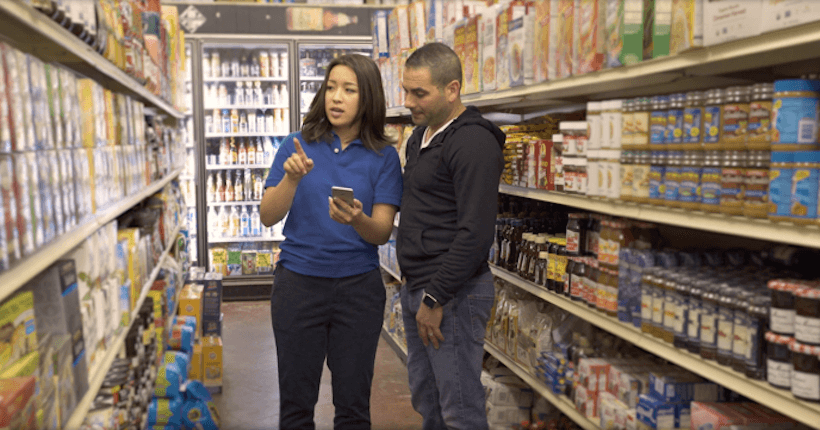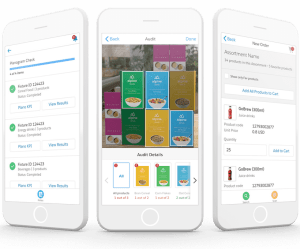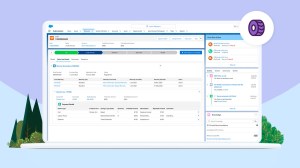Like every other industry, retail is in the midst of a massive transformation. Customer expectations have changed as the speed and convenience of ecommerce have redefined the shopping experience. But despite the rise of ecommerce through innovators like Amazon, 95% of all consumer goods products are still sold in physical stores, according to Nielsen research.
That doesn’t mean clear horizons ahead. For consumer-goods manufacturers, the retail endpoint doesn’t really matter — they must figure out how to get their products in front of consumers, whether that’s at a physical point of sale or a digital one. As Salesforce’s Industries team talked to customers, some who were using the Salesforce Commerce Cloud, it found that while most of them embraced ecommerce, they were also inspired by how ecommerce allowed them to gain deeper insights into how their products were reaching consumers, and how they could use those insights to empower their field reps to create a better retail experience.
“Our retail and consumer-goods customers told us that ecommerce is a perfect store because they can easily buy products, get information back from their customers, have real-time visibility into data trends, and gain direct access to the consumers,” explains Salesforce Senior Vice President of Retail & Consumer Goods John Strain. “They wanted us to help them translate some of those key advantages of ecommerce into the in-store experience.”
It was through a series of unique conversations with customers that Consumer Goods Cloud — Salesforce’s newest industry-specific offering — came into existence. Along with Manufacturing Cloud (the other product Salesforce announced September 16) Consumer Goods Cloud adds to a growing portfolio of industry-specific CRM products, joining Financial Services Cloud and Health Cloud. As with its predecessors, the core principles for Consumer Goods Cloud are the same: empower companies to leverage data and real-time insights in order to bring companies and their customers closer together.
The value add with the Industry Clouds is that Salesforce’s product and marketing teams zero in on speaking the language of the customer and understanding their specific needs, challenges, opportunities, and pain points. Through that process, new capabilities are identified and integrated into industry-optimized products that leverage the power of the Salesforce Customer 360 platform.
Consumer Goods Cloud is aimed at redefining point-of-sale for consumer-goods manufacturers — specifically optimizing how products are being placed at retail locations, how effective the delivery chain is at getting them there, and their exposure to consumers in stores.
According to the Industries team’s studies, some 46% of consumer-goods leaders reported they had no digital tools to track the effectiveness of so-called retail execution — getting the right products to the right stores at the right times — and that many were still using pen and paper to track records. What’s more, 52% of consumer-goods leaders say their merchandising and marketing plans aren’t executed as intended in stores, according to Salesforce Research. [Click to Tweet]

The opportunity crystalized in 2017. A small handful of large consumer-goods brands who were on the Salesforce platform began delivering the same feedback: We don’t have a solution to arm our field reps with the information they need to maximize the selling potential in store. They wanted to instrument the stores more like ecommerce sites, collecting and analyzing data that can drive sales and improve the customer and employee experience.
“Salesforce has always been the platform of choice for consumer-goods companies when it comes to retail execution,” explains Sunil Rao, Salesforce’s Global Head of Consumer Goods Go-to-Market Strategy. “We already had a massive base of customers that used us for retail execution, but we had many come to us asking for a more ‘out-of-the-box’ approach for retail execution.”
One such example came from a conversation with a senior leader of a major beverage company who simply suggested, “Why don’t you build one?”
The timing was perfect. Salesforce was in the process of doubling down on its strategy to work closer within specific sectors, including bringing in product and engineering leaders such as Executive Vice President and General Manager Jujhar Singh and Vice President of Product Management Kishan Chetan, who were both hired to deliver industry-specific solutions. Working with Rao and the go-to-market team, they prioritized the consumer-goods industry as an opportunity for product investment after reviewing the business case and listening to customers.
The immediate plan of action was to see exactly how many Salesforce customers were experiencing similar challenges, and document as many variations and subtleties as possible. At Chief Product Officer Bret Taylor’s suggestion, Rao, Chetan and a select team began mapping out a series of partnerships with customers — and conducted site visits to more than a dozen consumer-goods companies across North America and Europe, running the gamut from food and beverage, to personal care and grooming products, and beyond.
“Essentially what we do on these visits is collect the feedback from customers,” says Rao. “We ask them, ‘What’s important to you? How can we make this part of the product?’ They countered with, ‘How are you thinking about connecting the dots between planning, execution and commerce?’ For us, that’s why we were pursuing this — because we have a platform in Customer 360 that we can adapt to meet the needs of their industry.”
As a target end user of the Consumer Goods Cloud, Salesforce keyed in on field reps — the people responsible for delivering and monitoring how products were appearing at retail locations. The underlying goals of that data-driven, ecommerce-like approach included a number of actionable items, such as optimization of site visits to manage travel routes, to-do lists, and inventory checks. The team also wanted to ensure the experience was mobile-optimized for those on-the-go workers and that they had the tools to accomplish all of these things more efficiently, and in a way where they could collect data and derive actual meaning from it.

One of the most exciting features of Consumer Goods Cloud will be the integration of Salesforce’s Einstein artificial intelligence capability, something Chetan says customers were asking for not as an add-on, but as a core component of the product. With Einstein Vision, field reps will be able to take a photo of a retail display, and the machine-learning algorithm will help them understand if the products are being placed correctly and help with inventory control. In other words, no manual counting, no paper records, and the AI functionality makes a predictive decision on whether a store is fulfilling its promise to a consumer-goods manufacturer — and whether something needs to be adjusted as a result.
“The problem with retail is you just don’t have any visibility into what’s happening on your floor, so you feel like you’re blind,” says Strain. “This solution does provide the opportunity to capture feedback on thousands of points of interaction that happen every day. This is the opportunity to start to get the kind of information you get from your digital presence from your physical retail store.”
This is just the beginning for Consumer Goods Cloud. The Industries team continues to operate a pilot program with select customers who are stress-testing the product in their daily workflow and providing feedback.
“We’re getting good feedback,” says Ram Machiraju, a Senior Director of Product Management on Chetan’s team. “The key for us is having a perfect understanding of the customer and the store, how we augment that with artificial intelligence and tools customers can use, and what learnings we’ll take away from those discussions.”
The Fourth Industrial Revolution is pushing business to adapt and evolve, and it’s clear that many in the retail and consumer goods sector view Salesforce as an ideal partner to help them on this journey.
“If you’re more connected and more digital, then you’re in the right game,” muses Rao. “But you can’t start competing until you have the ability to drive action on real-time insights. That’s a guiding concept of digital transformation.”
Are you a member of the media? Feel free to use the quotes, assets, and content of this story how you see fit.















